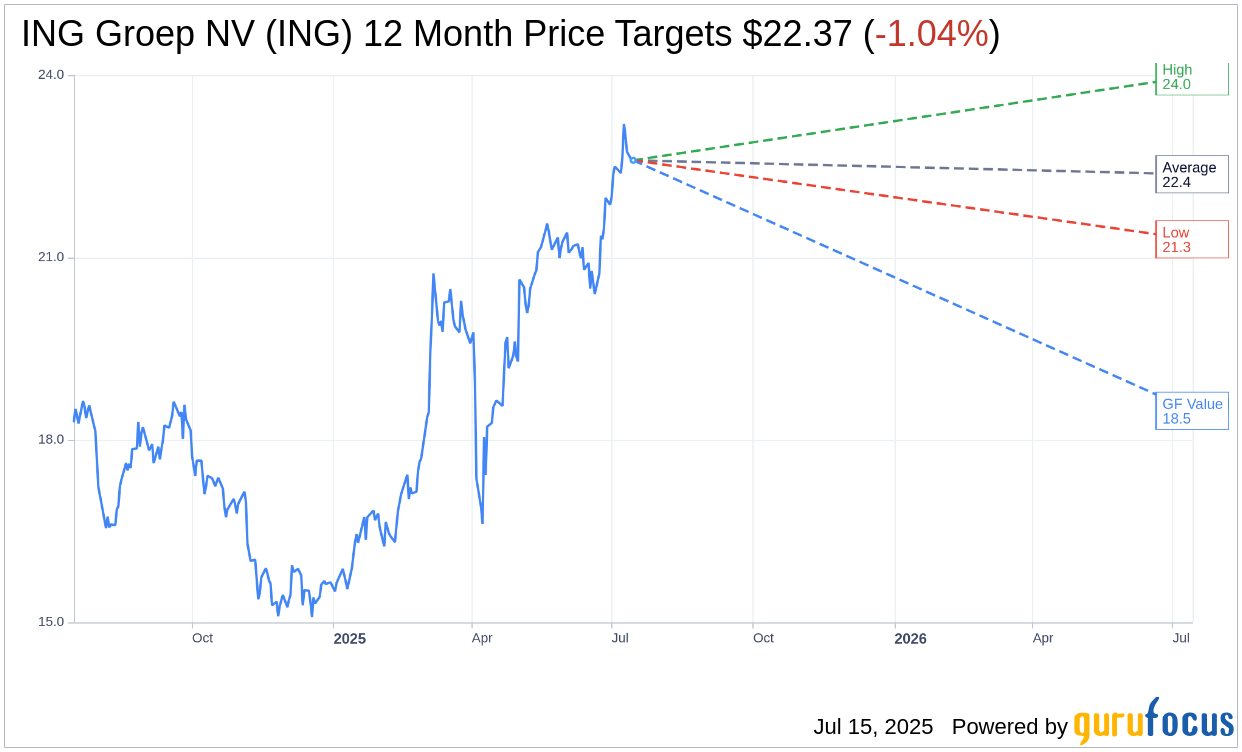Barclays has upgraded ING Groep (ING, Financial) from Equal Weight to Overweight, raising its price target from EUR 18.40 to EUR 24. The decision comes as Barclays assumes coverage of the company, citing expectations of a robust capital return yield from ING. The firm identifies the Wholesale Banking division as a significant area for potential improvement in returns, contributing to their positive outlook on the stock.
Wall Street Analysts Forecast

Based on the one-year price targets offered by 4 analysts, the average target price for ING Groep NV (ING, Financial) is $22.37 with a high estimate of $23.98 and a low estimate of $21.30. The average target implies an downside of 1.04% from the current price of $22.60. More detailed estimate data can be found on the ING Groep NV (ING) Forecast page.
Based on the consensus recommendation from 3 brokerage firms, ING Groep NV's (ING, Financial) average brokerage recommendation is currently 2.7, indicating "Hold" status. The rating scale ranges from 1 to 5, where 1 signifies Strong Buy, and 5 denotes Sell.
Based on GuruFocus estimates, the estimated GF Value for ING Groep NV (ING, Financial) in one year is $18.48, suggesting a downside of 18.23% from the current price of $22.6. GF Value is GuruFocus' estimate of the fair value that the stock should be traded at. It is calculated based on the historical multiples the stock has traded at previously, as well as past business growth and the future estimates of the business' performance. More detailed data can be found on the ING Groep NV (ING) Summary page.
ING Key Business Developments
Release Date: May 02, 2025
- Net Core Lending Growth: EUR8.6 billion, primarily driven by mortgages.
- Fee Income Growth: Increased by 10% compared to the first quarter of last year.
- Sustainable Finance Mobilized: EUR30 billion, a 23% increase from the first quarter of last year.
- CET1 Ratio: 13.6% at the end of the first quarter.
- Share Buyback Program: Announced EUR2 billion share buyback.
- Total Income Increase: Significant increase compared to the previous quarter.
- Net Core Lending Growth in 1Q 2025: EUR6.8 billion, mostly driven by residential mortgages.
- Core Deposits Increase: Almost EUR23 billion in the first quarter.
- Operating Expenses Increase: Just over 6% in the first three months of the year.
- Risk Costs: EUR313 million, or 18 basis points of average customer lending.
- Stage 3 Provisions: EUR215 million, mainly related to collective provisioning in consumer and business lending.
For the complete transcript of the earnings call, please refer to the full earnings call transcript.
Positive Points
- ING Groep NV (ING, Financial) reported exceptional growth in deposits and higher mortgage volumes, indicating strong commercial growth in the first quarter of 2025.
- The company recorded a significant increase in fee income, which was 10% higher than the first quarter of the previous year.
- ING Groep NV (ING) continues to support clients in their sustainability transitions, with sustainable finance mobilized rising 23% from the first quarter of last year to EUR30 billion.
- The company announced a share buyback of EUR2 billion, reflecting strong capital generation and commitment to shareholder returns.
- ING Groep NV (ING) maintained a robust capital position with a CET1 ratio of 13.6%, allowing for consistent cash distribution to shareholders.
Negative Points
- There was a modest decline in lending within Wholesale Banking, attributed to seasonal volatility and capital optimization efforts.
- The introduction of tariffs and macroeconomic uncertainty have led to a lower growth outlook worldwide, impacting the company's strategic planning.
- Operational expenses increased by over 6% in the first quarter due to inflationary pressures and continued investment in business growth.
- The lending margin is expected to come down slightly in the second quarter, driven by a change in lending mix and funding of the mortgage book.
- Stage 1 and Stage 2 risk costs increased, reflecting updates in macroeconomic forecasts and some risk migration.
